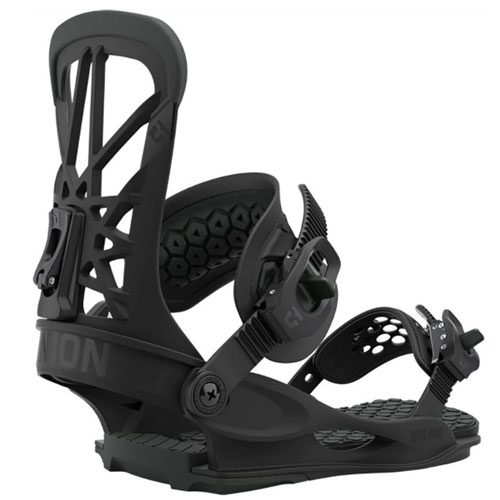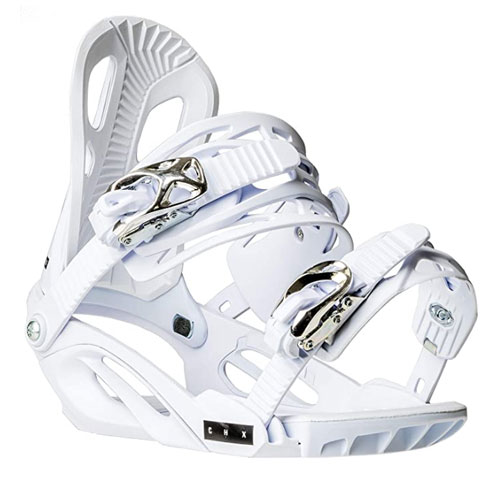
From performing tricks in the park to riding powder off-piste, snowboard bindings are an important part of your snowboarding experience. Not only do they keep you secured to your board, but they also improve the board’s response and the overall comfort.
Choosing the right snowboard bindings depends on two things – your riding style and skill level. To help you decide, we’ve created a buying guide where we’ll discuss all the features you need to consider. In addition, we’ve also carefully selected the best all-mountain snowboard bindings so you can make the most out of every run on the snow.
OUR TOP PICK
Burton Malavita EST
- Stand Out Features - Why We Love It
- AutoCant footbed keeps your joints in an optimal position
- FullBed EVA cushions dampen the impacts and vibrations
- Double Take buckles make adjustments quick and easy
- Supergrip Capstrap keeps the feet secure without pressure
- Good shock absorption
Best For: Park Performance
Riding Style: Freestyle, All-Mountain
Baseplate: Dual-Component EST (Short Glass, Nylon Composite)
Mount: Channel
Highback: Canted Living Hinge Zero-Lean
Ratchets: Double Take Buckles with Insta-Click
Flex: Medium (5-7)
Skill: Intermediate/Advanced
EDITORS CHOICE
Union Flite Pro
- Stand Out Features - Why We Love It
- Ultralight Duraflex construction for all-day riding comfort
- Thermoformed EVA baseplate padding for shock absorption
- Medium soft flex works great for beginners and learners
- Lifetime warranty coverage on baseplate and heel cup
Best For: Comfortable Riding
Riding Style: All-Moutain, Freestyle
Baseplate: Flight Duraflex
Mount: 4×2, 4×4, Channel
Highback: CP1
Ratchets: Aluminum
Flex: Medium/Soft
Skill: Beginner/Intermediate
BEST VALUE
Chamonix Cheval
- Stand Out Features - Why We Love It
- 3D ankle strap and tough toe cap keep the boot secure
- Padding on the baseplate toe and heel makes landings softer
- Metal buckles for easily adjusting the fit and tightness
- Universal mount is compatible with almost all boards and boots
- Good shock absorption
Best For: Off-Piste Riding
Riding Style: All-Mountain, Freeride
Baseplate: Polycarbonate
Mount: 4×2, 4×4
Highback: Asymmetrical
Ratchets: Combo, Metal
Flex: Medium
Skill: Beginner/Intermediate
- Stand Out Features - Why We Love It
- Stiff flex works great in powder and difficult terrain
- Composite baseplate feels great and has a quick response
- AutoCant footbed naturally aligns the joints while riding
- SensoryBed and B3 gel dampen the shocks when jumping
- Good shock absorption
Best For: Powder and Deep Snow
Riding Style: All-Mountain, Freeride
Baseplate: Dual-Component EST (Short Glass, Nylon Composite)
Mount: Channel
Highback: DialFLAD, Heel Hammock
Ratchets: Smooth Glide Buckles, Flex Slider
Flex: Stiff (7-9)
Skill: Intermediate/Advanced
- Stand Out Features - Why We Love It
- Urethane highback with Cube lean adjustment system
- Strong but lightweight forged aluminum ratchets
- Flex Control drive plate gives you top-level edge control
- Calcium Bi-Ax baseplate feels great when riding freestyle
Best For: Performing Tricks
Riding Style: Freestyle
Baseplate: Calcium Bi-Ax Driveplate
Mount: Universal
Highback: Urethane + The Cube Lean Adjustment
Ratchets: Forged Aluminum
Flex: Medium
Skill: Beginner/Intermediate
- Stand Out Features - Why We Love It
- Stiffest flex in our snowboard bindings review makes it ideal for off-piste riding
- N-Gel base padding absorbs impacts from hard landings
- Rockered aluminum alloy plate with impressive response
- Rear-entry system makes strapping and adjustments easy
- Good shock absorption
Best For: Deep Snow, Off-Piste
Riding Style: Freeride (Powder)
Baseplate: Rockered NX2 (Aluminum) with N-Gel Padding
Mount: Universal
Highback: ASYM Uniback Fuse
Ratchets: Aluminum Locking Slap
Flex: Very Stiff (10)
Skill: Advanced
5th Element Stealth 3
- Stand Out Features - Why We Love It
- Excellent entry option for beginner snowboarders
- Well-designed highback equipped with a lean adjuster
- Convertible toe strap easily conforms to any boot shape
- Standard 4-hole mount works great with most snowboards
Best For: Learning, Improving Technique
Riding Style: All-Mountain, Freestyle
Baseplate: Plastic
Mount: 4×2
Highback: Plastic
Ratchets: Plastic
Flex: Very Soft
Skill: Beginner
- Stand Out Features - Why We Love It
- Composite baseplate with medium flex performs great in all situations
- Heel Hammock allows you to loosen the ankle straps without reducing response
- Flex Slider moves the straps so you can easily place the boot inside
- FullBed cushioning system dampens vibrations and provides support
- High performance shock absorption
Best For: All-Around Snowboarding
Riding Style: Freestyle, All-Mountain
Baseplate: Re:Flex (Single-Component Short-Glass/Nylon Composite)
Mount: Universal
Highback: Canted Living Hinge Zero-Lean
Ratchets: Double Take Buckles with Insta-Click
Flex: Medium (5-7)
Skill: Intermediate/Advanced
Flow Alpha MTN Rear Entry
- Stand Out Features - Why We Love It
- High-quality LSR ratchets make entry and adjustments easy
- Rockered baseplate for a better feel and performance
- Asymmetrical highback reduces the pressure when leaning
- Great option for people who want to improve their technique
Best For: Easy In and Out
Riding Style: Freestyle (Park)
Baseplate: H-Series (POM Composite Plastic)
Mount: 4×2, 4×4, Burton 3D
Highback: Molded Composite UniBack
Ratchets: Locking Slap Ratchet (LSR)
Flex: Soft
Skill: Beginner/Intermediate
- Stand Out Features - Why We Love It
- Ideal option for all Burton snowboard with Channel mounts
- Dual-component baseplate feels playful without losing performance
- Best snowboard bindings for freeride enthusiasts
- SensoryBed cushioning system make the ride soft comfortable
- Good shock absorption
Best For: Quick Response
Riding Style: All-Mountain, Freeride
Baseplate: Dual-Component EST (Short-Glass/Nylon Composite)
Mount: Channel
Highback: Canted Zero-Lean Hi-Back (Short-Glass/Nylon Composite)
Ratchets: Double Take Buckles with Insta-Click
Flex: Medium (5-7)
Skill: Intermediate
How To Choose The Best Snowboard Bindings – Buying Guide

Type of Snowboard and Flex Rating
There are four basic types of snowboards, all of which require different binding stiffness. Snowboard binding flex rating is measured on a scale of 1 to 10, where a lower number is softer (more forgiving) and a higher number is stiffer (faster response).
All-mountain: This type of snowboard is meant to go anywhere on the mountain and tackle any terrain conditions. The best bindings for this type of snowboard should have a medium to softer flex.
Freestyle: Freestyle snowboards are used in parks (on rails and jumps) and require a soft flex binding that provides comfort and tolerates mistakes.
Freeride: The freeride snowboard is meant to be used in off-trail locations and ungroomed conditions. Whether snowboarders are in the trees or on cliffs, the best freeride snowboard bindings need to be stiff.
Powder: These snowboards are built for the deepest powder conditions and need the stiffest bindings for the best control (flex rating 9 or 10).
Material
The lightest bindings are often made of durable plastic (like polycarbonate) because it’s sturdy without packing on the pounds. The most efficient snowboard bindings on the market are lightweight in order to enhance the performance. However, if you want additional durability, materials like nylon and aluminum are strong and durable in cold temperatures.
Highback
The highback is the plate that travels from the heel of your boot to the lower calf. It’s important because it gives you control over the heel-side edge of the snowboard. Shorter high backs will often be softer and good for beginners, while longer highbacks are stiffer and better for all-mountain riders.
You might also like: Top Snowboard Gloves
Base Plate and Padding
The base plate is the piece that connects your bindings to the snowboard. Base plates can be made of a variety of materials and, like the highback, they have an individual flex rating. The best all mountain snowboard bindings on the market should have a padded plate because this gives you better support while reducing chatter and vibration.
Size and Fit
The size of your boot will determine the fit of your bindings. Most binding brands will include a size chart with a comparison table that is based on men’s or women’s snowboard boot sizes. Some of the best all-mountain bindings may fit the boot exactly while others fit a range of sizes.
For an accurate fit, we advise that you use the provided size chart. If you are between sizes and concerned about which one to get, you can look at snowboard binding reviews and see if the particular model runs large or small.
FAQs

Q: How Do Snowboard Bindings Work?
Snowboard bindings are the connection between your boots and your snowboard. They are firmly attached to the board while allowing you to open and close them as you take your boots in and out. Thanks to them, you can easily transfer the force to the board and control it.
Q: What Snowboard Binding Size Do I Need?
You should choose a binding size that fits your boots properly. Luckily, most bindings are adjustable and accept several boot sizes (for example 9 to 11). Still, we advise that you always check the manufacturer’s size chart before buying.
Q: How Tight Should Snowboard Bindings Be?
They should be tight, but not press on your foot too much. In other words, the pair of bindings should be tight enough to prevent your foot from shifting or slipping around. This gives you enough control over your board without causing discomfort.
Q: What Are Hybrid Snowboard Bindings?
A hybrid snowboard binding combines two different binding methods into one, for example a traditional over-foot style with a toe-cap style. This type of combination improves security and makes bindings more comfortable.
Q: How Do Snowboard Bindings Attach?
Most models use 4x2 and 4x4 mounts, but other brand-specific options are available too. Because attachments aren’t standardized, you should pay close attention when choosing and get a model that is compatible with your board.
Q: How Long Do Snowboard Bindings Last?
The snowboard bindings are made of durable materials that last for a very long time. However, giving an exact estimate is difficult because it depends on how often you hit the mountain, the conditions you face, and your skill level. For an average snowboarder, bindings usually last from 3 to 4 years.
Globo Surf Overview
Snowboard bindings are among the most important equipment for any snowboarder, regardless of the skill level. The top rated all-mountain snowboard bindings will make sure that you are secure on your board while giving you full control over the ride. We hope that our guide has made things a bit clearer so you can easily choose the most efficient snowboard bindings for your riding style.











